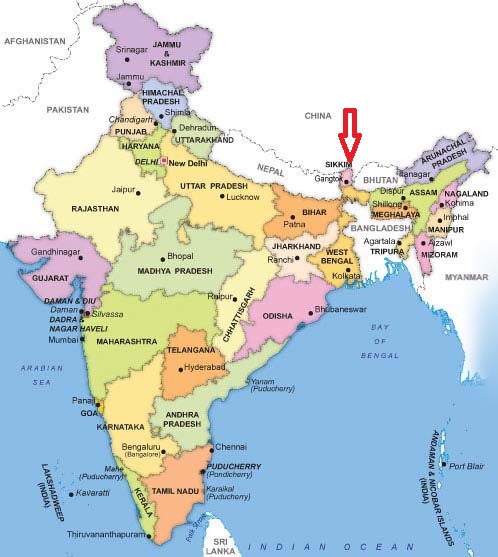The former Buddhist Kingdom of Sikkim merged with India in 1975. Located between Nepal, Tibet and Bhutan, its situation is out of any major circulation axe and it remains a remoted and a poor land. It opened recently to tourism, but a specific visa is still necessary to get inside Sikkim. Authorities are specially looking after North-Sikkim in consideration to its different borders which include China.
The district is the largest of the four districts of Sikkim.
The landscape is mountainous with dense vegetation all the way up to the alpine altitude before thinning out to desert scrub towards the northern tundra. Numerous waterfalls astride the main road make the trip to this district extremely picturesque.
The most prominent effect of the steepness of the valleys is the prevalence of landslides that at times drop to anything between 3000 and 5,000 ft (1,500 m) carrying devastation along their course. Most of them are caused either by the melting snow beds on top of the mountains or by erosive action of the rains.
Most of the people of the state reside near Mangan, the district headquarters which is about 2,000 feet (610 m) above sea level. Further north the elevation increases with the vegetation turning from temperate to alpine to tundra. Temperatures range from about 25° to below −40° in the extreme high reaches where the altitude is in excess of 6,000 metres. Kanchenjanga is the highest peak at over 8,000 m, straddling its western border with Nepal and can be seen clearly from the town of Singhik.
Population of North-Sikkim is estimated to 44 000 inhabitants, spread among over sixty villages. With 10 persons per square kilometer, it’s one of the lowest district of India in term of population.
Mangan is known as the Cardamon Capital of the world. The climate and terrain best suit the cultivation of the larger variety of Cardamom here.
North Sikkim is home to the red panda (Ailurus fulgens), a vulnerable species. This animal is the pride of Sikkim and is also the State Animal. It is generally found between heights of 2000 m to 4000 m. It is as big as a domestic Siamese cat (approximately 2 ft long), has a triangular shaped face with a stripe on its cheek, with red fur and black eyes. They generally live on treetops.
In 1977 North Sikkim district became home to Khangchendzonga National Park, which has an area of 1,784 km2 (688.8 sq mi). It shares the park with West Sikkim district. It is also home to the Shingba (rhododendron) Wildlife Sanctuary, which was established in 1984 and has an area of 43 km2.
The roads of North-Sikkim are, most of them, in poor conditions and they need to be repaired continuously because of the weather conditions.



